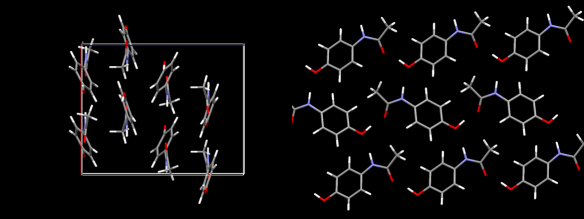An elusive polymorph of Paracetamol
What does it look like?

Image generated by the Mercury crystal structure visualisation software http://www.ccdc.cam.ac.uk/Solutions/CSDSystem/Pages/Mercury.aspx
What is it?
All of this blogging is starting to cause a few headaches! Luckily we have paracetamol on hand to help out. Understanding crystal structure is a vital part of every aspect of drug design, from finding out how they interact in our bodies to how they pack into the pills we need to take.
Hence it's a requirement that before a drug goes onto our shelves that its crystal structure is fully understood. Crystal structure can help us understand many physical properties of a material, and one very relevant to the drug industry is solubility. An insoluble drug is useless as our bodies can't break it down and use it.
This can get a bit complicated if the drug in question can form more than one type of crystal structure, and paracetamol is no exception to this. There are, in fact, three forms (or polymorphs) of paracetamol. Forms I and II have been known about for quite a long time, but Form III was only fully understood in 2008 and is the structure featured here. To find this out the researchers had to combine powder diffraction with state-of-the-art crystal structure prediction. In this structure the paracetamol molecule layer up, but are tilted slightly compared to the other forms.
Where did the structure come from?
Form III of paracetamol was worked out by Perrin et al. in 2008.






